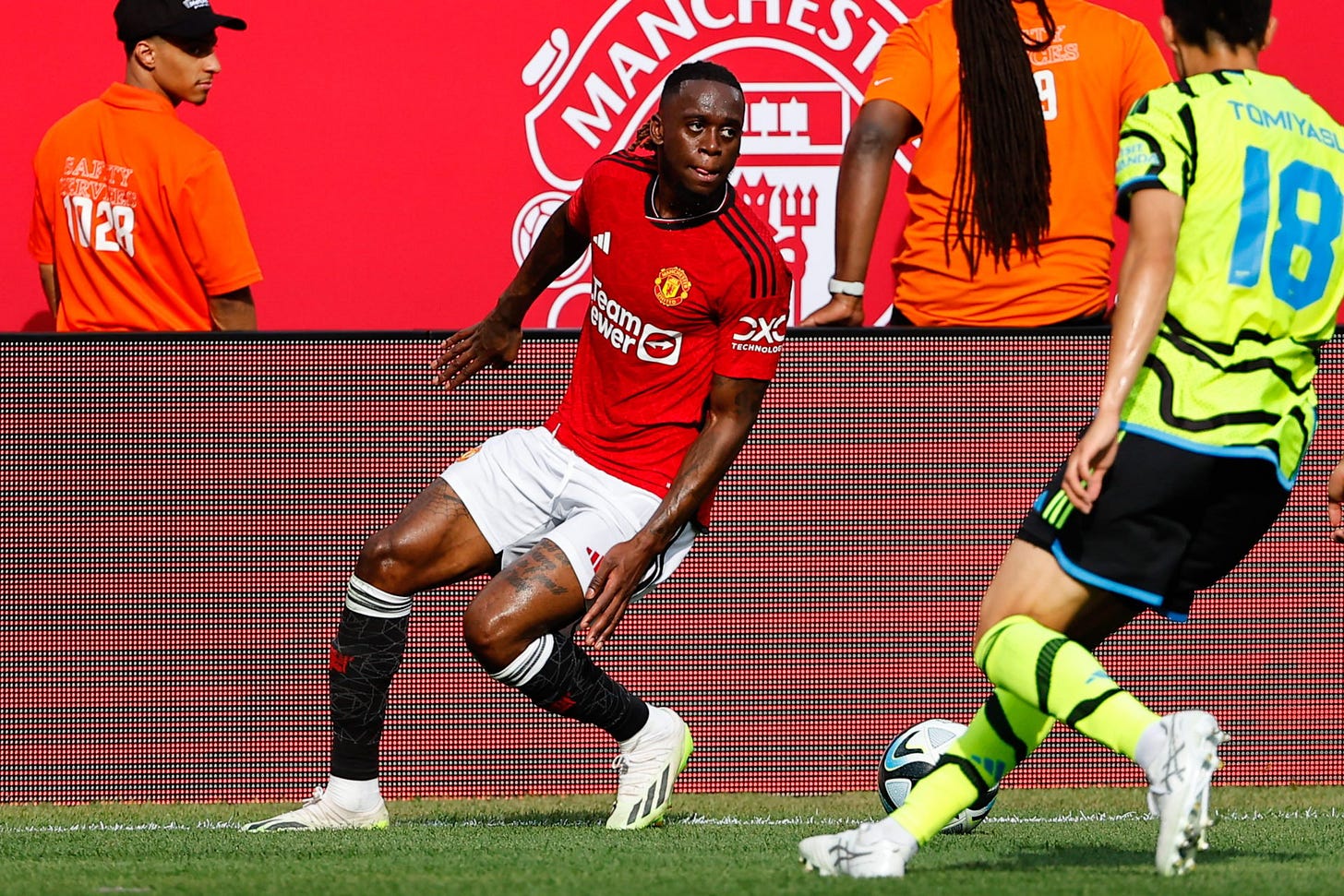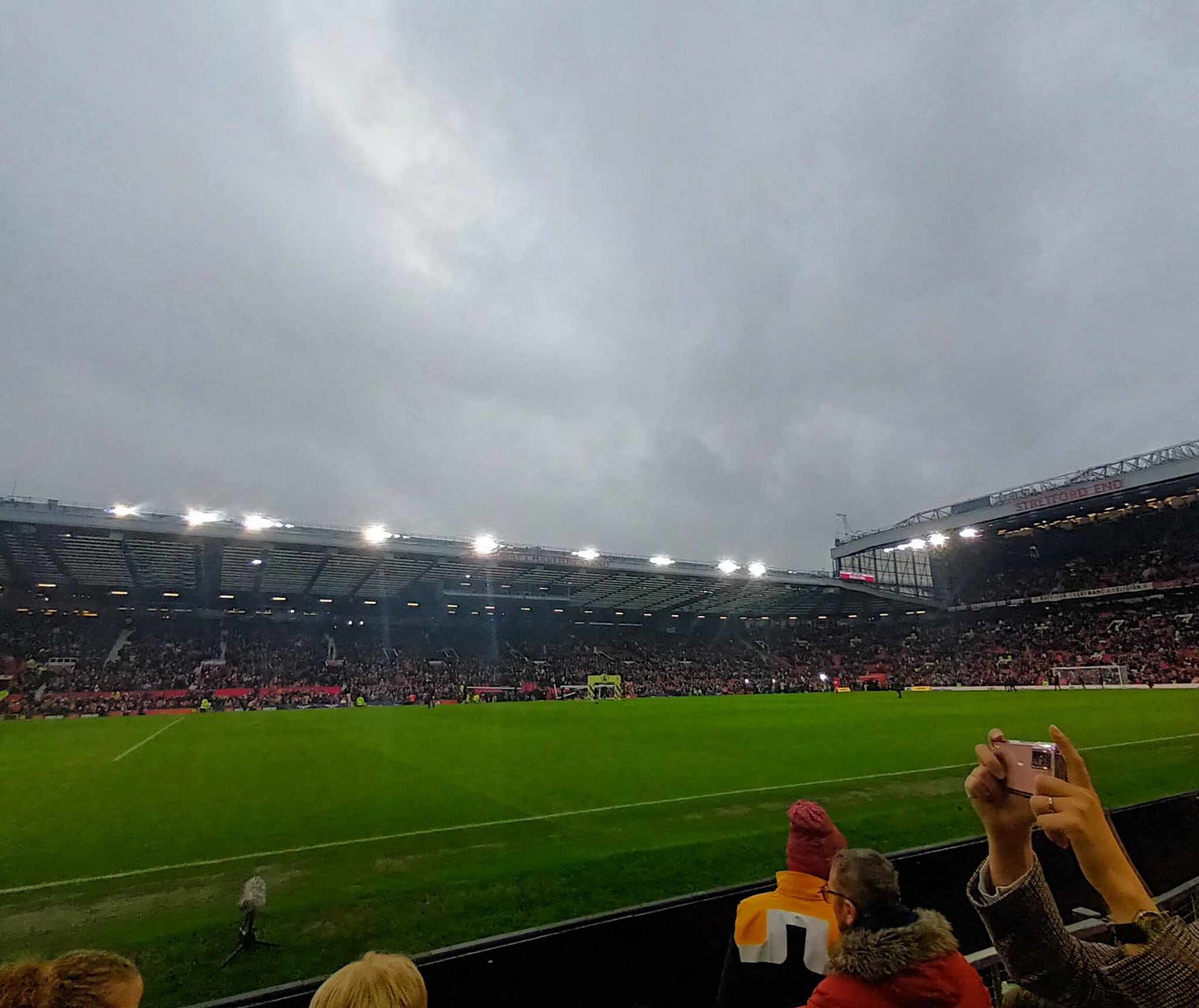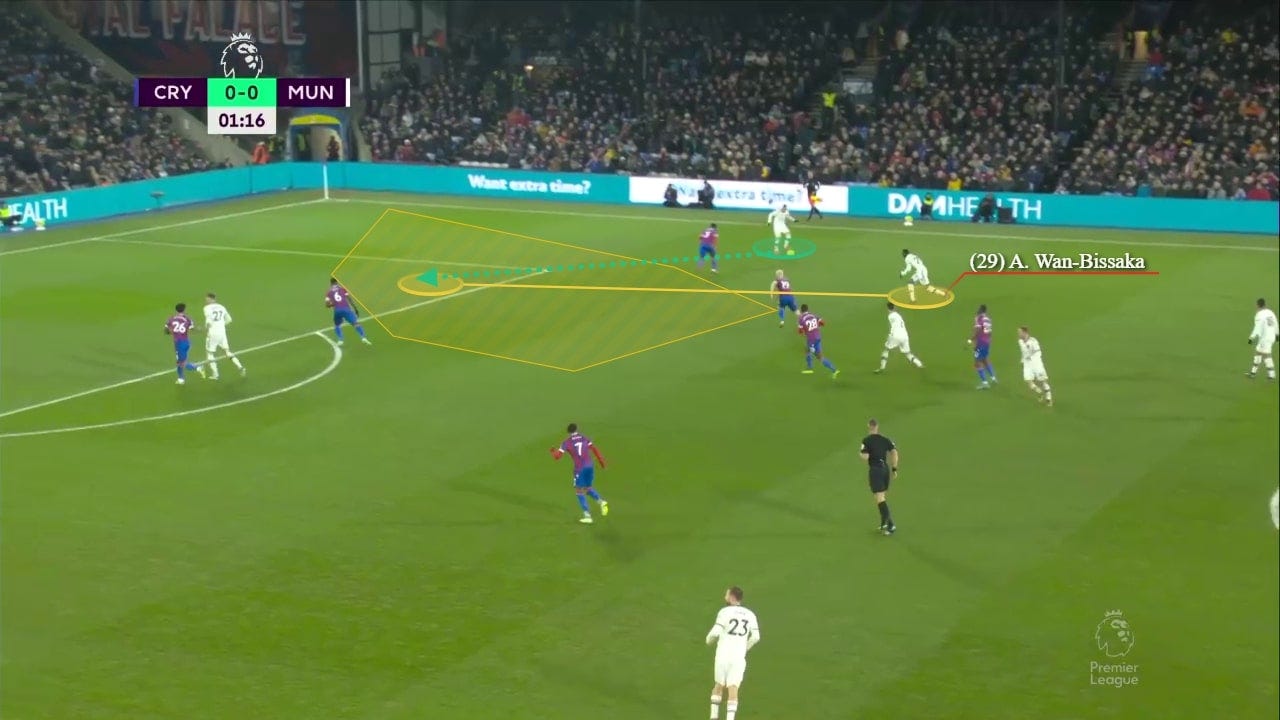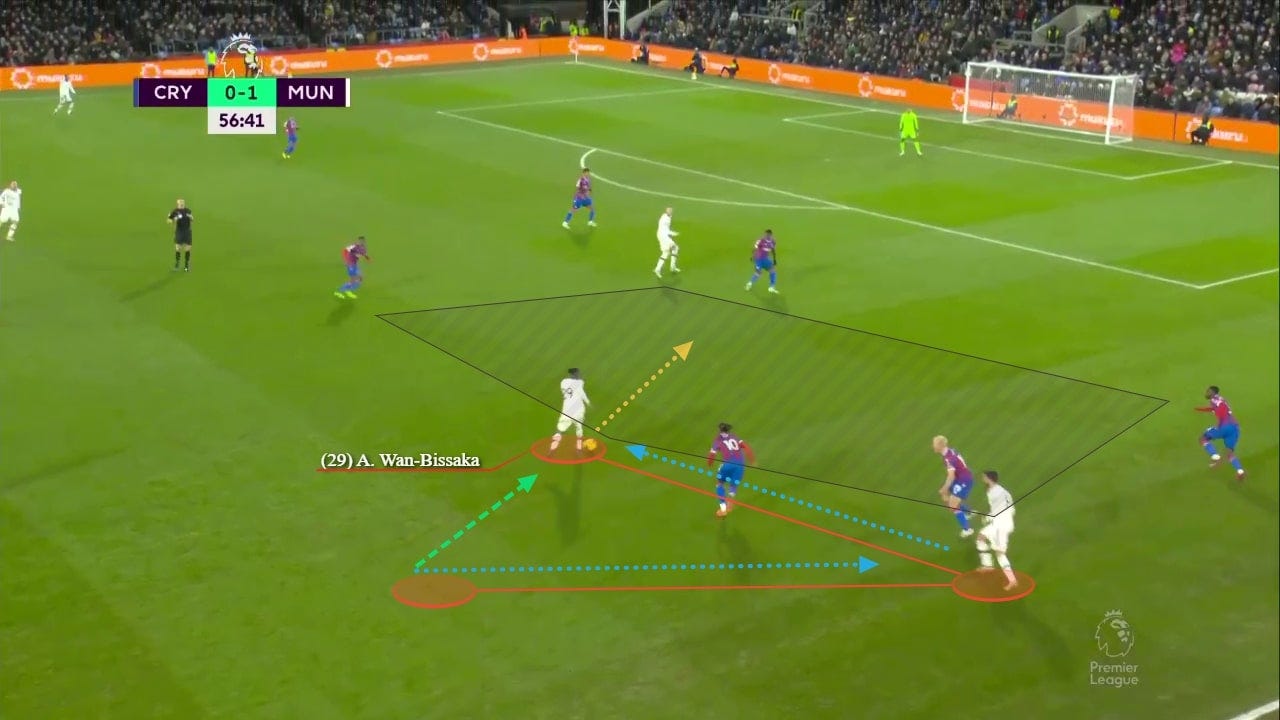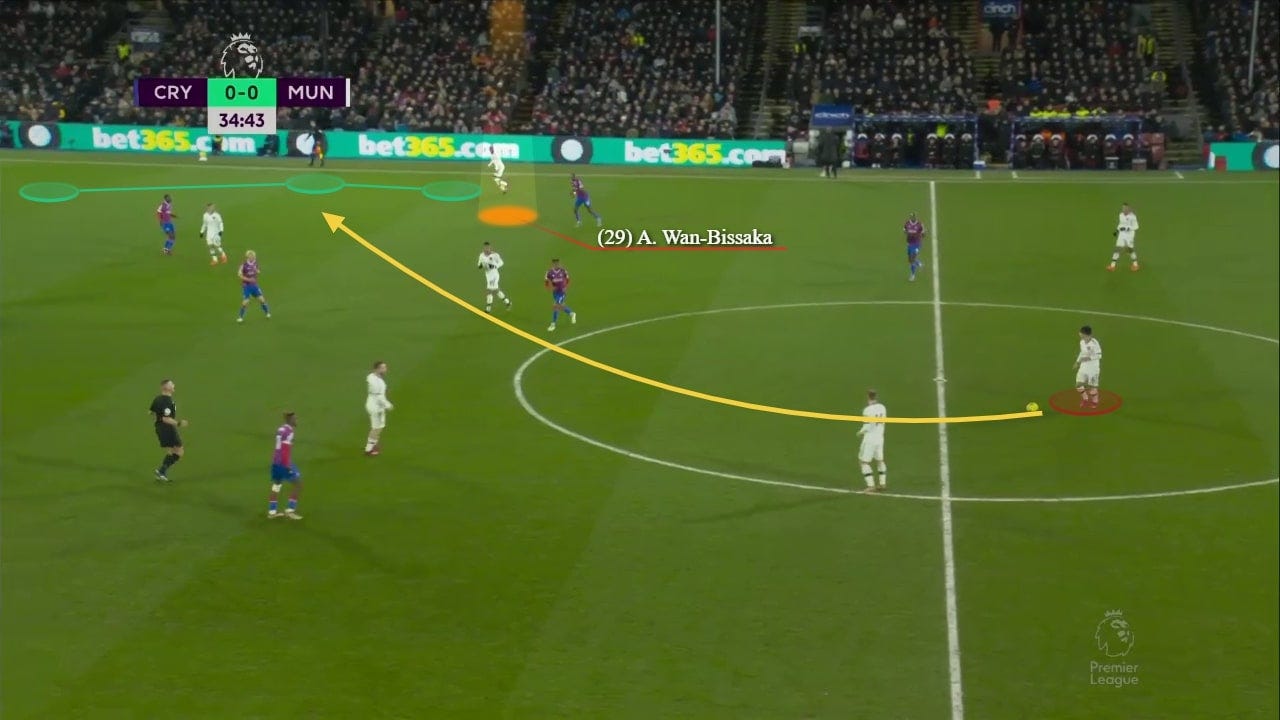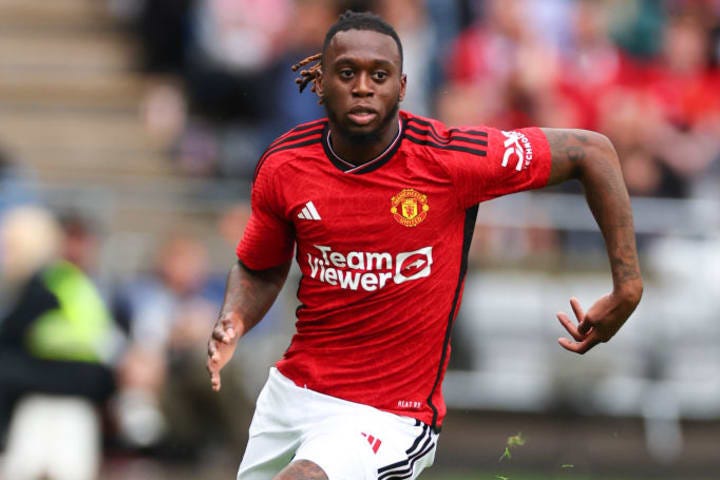Defending the Spider's Web
Aaron Wan-Bissaka has long been known as the best 1-on-1 defender on the planet. But is that all that he is?
“When it’s me against you, he’s as good as anyone out there,” Rio Ferdinand said after Manchester United’s FA Cup semi-final triumph over Brighton, eulogising over the go-go gadget legs of Aaron Wan-Bissaka.
Kaoru Mitoma, who tore right-backs to pieces throughout an incredible breakthrough season, described his tussle with Wan-Bissaka as a “complete defeat”.
The full-back’s performance against Brighton prompted former Leicester, now Spurs star James Maddison to take to Twitter. ‘AWB is ridiculously good at 1 v 1 defending,’ he wrote. ‘Probably the best in the world bar none. So many wingers run out of ideas when playing directly against him.’
Crystal Palace winger Wilfried Zaha hailed Wan-Bissaka after the defender produced an outstanding last-ditch tackle in the dying seconds of last season’s 1-1 draw at Selhurst Park. Zaha, speaking to Sky Sports, said: "Any other player [I would have got away from]. As I was running through, I had a little look back and thought, 'Oh my God, it’s Aaron'. He’s the only one that can do that scoop tackle. It was such a great tackle."
Nicknamed “Spider”, Wan-Bissaka remains an enigma.
In many cultures, Spiders are the mythological representations of the Trickster, a god/spirit/human who exhibits a great degree of intellect and uses it to play tricks on other characters, stealing items from their possession, and teaching the readers a lesson to never cross their path lest they have their possessions stolen too.
A fitting nickname then for a defender that uses both their long legs and their expert cunning to strip attackers of the ball.
Wan-Bissaka being described as the standout one-on-one defender in the world is nothing new.
But the numbers are startling.
At the end of April it was revealed by FBref that of the 2,168 players to have attempted 100+ tackles in Europe’s top five divisions since the start of the 2017-18 season, no one had a better tackle success rate than the 25-year-old. He had (at that point) stolen the ball 449 times in 571 attempts, an astonishing rate of 78.6%. No other full-back in Europe came close.
The way he tucks in to maintain compactness, offers covering support to colleagues and knows when to step out, drop back, shift across or hold his post has only added to his worth. He’s even improved further defensively, having been weak on crosses approaching him at the back post in previous years, allowing a lot of goals and chances from his mistakes in this area.
Moreover, the terrific judgement and precision he displays when applying his interventions has been another vital string to his bow. He’s a master at nipping in and timing his tackles to regain possession in ground duels and holds his own in aerial duels courtesy of his leap and judgement of the ball’s flight path.
Operating with authority, clarity, and a quiet intensity, his stopping presence has been instrumental towards the Red Devils looking so solid defensively.
Having spent most of his formative professional years marking Wilfried Zaha and Yannick Bolasie, two of the trickiest dribblers the Premier League has had, Wan-Bissaka was forced to quickly develop. Speaking to the Guardian in 2019, he emphasised how important this period in his career was. “Training up against Wilf and Bolasie toughened me up,” said Wan-Bissaka. “When I was younger my playing style was like Wilf’s, so that sort of gave me a heads-up. But he’s still a tricky one. As an ex-winger, you get a sense of what they’re trying to do: which way they might go, how they’re thinking. You can anticipate things easier … I have no idea where I get [my tackling] from, and I’m just as confused when I see all the stats.”
Yannick Lufakalyo, a renowned technical coach that the player invited to his house last year for specialist training sessions, calls his client’s defending “effortless”, while highlighting a mentality shift as the reason for his upturn in form last season.
“If you play for United, coaching is more about honing a player’s confidence,” Lufakalyo says. “Aaron was used to playing week-in, week-out. He is strong mentally but there comes a point in life where everyone gets challenged. I think he’s through that period now, and now the sky is the limit.
“Aaron is genetically gifted, but his biggest strength is that he can time everything on point. We worked a lot on his dribbling: I was shocked at how good he was technically. The first conversation I had with him was to tell him, ‘You’ve got the ability.’”
Author’s note
I feel that the underrating of Aaron Wan-Bissaka’s technical abilities, and the diminishment of his strengths until they just boil down to “strong, powerful, fast, great defender” falls in line far too often with a horrible theme for players with African ancestry/origins.
Too often are his physical traits the chief focus. The vast majority of the many pieces I have read from other writers in my research for this one focus almost exclusively on these points in relation to Aaron. His strength, his power, his pace. Of course these are valuable to mention, but holding them as your chief points, and labouring over them again, and again, again, frankly, I find it disgusting. Sportswriters need to step away from this type of writing. There’s no excuse to find your analysis pieces falling directly into this area.
This will not be a common theme of this piece. Nor should it ever be an ongoing theme of any analysis of a player, no matter their background.
There are obviously flaws to Aaron Wan-Bissaka’s game. Of course there are.
Pobody’s Nerfect.
He was always something of a ’90s throwback: an excellent defensive full-back who provides infrequently and ineffectively in the attacking third. And while there’s been a marked improvement under Erik ten Hag on the front foot, so low was the bar previously, Wan-Bissaka can still pale in comparison to some of his counterparts statistically in important areas.
Last season he delivered 0.15 crosses into the penalty area per game – the same as then Southampton player Mohammed Salisu (a centre-back). Even full-backs deemed to be as defensive as Wan-Bissaka cross the ball more frequently – Tyrick Mitchell (0.28); Seamus Coleman (0.34) – while Big Seven counterparts Ben White (0.38), Reece James (0.43), Kieran Trippier (0.80), Trent Alexander-Arnold (0.83) and Pedro Porro (1.18) do so significantly more often.
Context for this point is key though, as it is with every statistic you’ll ever read.
Manchester United aren’t a side that cross much in general. According to WhoScored, United ranked 17th in the Premier League in crosses attempted per game last season. There’s a clear factor here, in that The Red Devils did not have a dedicated #9 they could consistently deliver the ball in to. With Rasmus Højlund being signed recently, as well as another #9 potentially coming into the club before the end of the summer window (Mehdi Taremi please), these stats will ramp up dramatically in the coming season.
He also clearly has some issues with mid- to long-range passing under pressure, as his body shape when he receives the ball, and the way in which he shapes his body to pass leaves him open to fast and intelligent pressers. This means that a lot of the time his long balls are rushed, or he just cancels the long pass altogether in favour of a simple short pass, or a progressive run forward, both of which he holds as excellent strengths to fall back on.
In terms of technical ability, Aaron Wan-Bissaka is severely underrated.
Wan-Bissaka’s short passing ability is astounding. He works wonderfully well in tight spaces, using his body and long legs to protect the ball, showing off his technical prowess, lightning-quick clarity of thought, and his vision to slide passes into even the smallest of gaps. For example, here’s a magical sequence he played a part in last season with another technically adept player making considerable improvements under Ten Hag, Jadon Sancho:
Much like Sancho, offensively Aaron Wan-Bissaka is a player that works best when the players around him are making supporting runs. He’s never going to be a dynamite creator by himself, but with intelligent high IQ footballers surrounding him, he can play a major role in the most intricate sequences of play.
After a poor start to last season where Aaron only appeared in one game from August to late December, Erik ten Hag saw enough in training to bring Wan-Bissaka into his team during the time of the Christmas fixtures and he has been a regular since. One of his best games was in the Manchester derby, when United came back from a goal behind to win. I was pitchside at Old Trafford that magical day, and got to see Wan-Bissaka’s improvements up close.
Here is where I bore witness to some of the more severely underrated parts of Wan-Bissaka’s footballing ability, most significantly his progressive carrying and close control.
66 minutes into the second half, Wan-Bissaka gathered the ball inside his own half as City, feeling under no threat by the man in possession, starting eating a picnic until some more urgent defending was required.
Acting as if the whole city team had just said some nasty things about his mother, the United defender slipped a ball through the legs of an advancing Jack Grealish with ease before passing the ball off to Casemiro.
After Casemiro luckily avoids a challenge from De Bruyne and slices a hurried pass straight into the legs of his opposite #6, the ball dropped back to Aaron’s feet, and he decided upon chaos.
Bernando Silva had his pants pulled down. Rodri was sent on the next easyJet flight back to Madrid. Joao Cancelo was turned inside out like a pair of dirty boxers that needed to be used two days straight.
These weren’t lucky motions. Aaron Wan-Bissaka is just that talented with his feet. He did stuff like this consistently throughout his run in the second half of last season. Here’s another example of his progressive dribbling ability, this time from the FA Cup semi-final against Brighton, the game which earned him those plaudits from the beginning of this piece.
When it comes to his output with the ball at his feet, he’s been cutting a massively improved figure in recent months. He was never particularly awful at it, but he did have a tendency to move about like a newborn giraffe, which caused scorn from fans and critics alike.
Now, looking far more dangerous on the dribble, his strength, pace, power, crisp changes in pace and direction and slick shoulder drops have been a vital source of offensive impetus.
Appearing far more comfortable and composed, his ball carrying has been crucial towards him outfoxing markers and gaining separation to assess his options before firing off passes.
Wan-Bissaka ranks in the 78th percentile in progressive carries, and the 77th percentile in successful take ons. Couple that with his noted defensive prowess, this makes the right-back one of the most dangerous 1v1 threats in the world on both sides of the ball.
As Rashford scored the winning goal in the Manchester derby, and sent Old Trafford into raptures (and I hugged 6 people I have never met and likely will never meet again), it was Wan-Bissaka who was at the back post supporting his attackers.
On the training pitches of the club's Carrington headquarters, this has formed part of a series of precise instructions Ten Hag has given on how he wants his full-backs to play. That is why Wan-Bissaka has been "inverted" into midfield at times, or making overlapping runs and ending up sometimes as the furthest man forward for United.
Dovetailing brilliantly with his teammates and clearly taking on board ten Hag’s tactical instructions, his positioning and movement have been integral towards his success. Playing a key role in build up, where he often stays deeper to form a temporary back three to help create positional and numerical superiorities, this has assisted the team in beating the press and progressing through the thirds.
Moreover, this withdrawn positioning also gives United some balance and structural security, as it allows his nearby winger the freedom to attack any foes 1v1, knowing Wan-Bissaka can provide cover on the transition if a turnover is forced.
Should a turnover be forced, the stoic Wan-Bissaka is always in the prime position to advance onto the man that’s dispossessed his teammate and whisper a Tim Duncan-esque “Oooo, almost” in his ear to start a United break from an advanced position.
There are few other players you’d want in that area, with the right-back ranking in the 85th percentile on interceptions amongst his peers.
From this base, it’s also been notable how he’ll interchange infield and act as an extra midfielder to give the ball holder another option to generate overloads in this area of the pitch. Impressively, he’ll also embark on crafty underlaps into the final third when the winger is pinning their man (typically Antony) wide to add some variety into the team’s final third adventures.
These runs are excellent at creating space for his teammates. Much like a screen setter in Basketball, he won’t ever officially get the assist for many of the scoring opportunities he sets up, but without him, those opportunities wouldn’t have come about.
With much of this play becoming more refined as United have been afforded more time on the training ground over the summer, we’re sure to see an increase in the quality and quantity of Aaron’s crossing over this next season, as he receives and carries the ball in better areas around the box.
The Englishman also deserves credit for picking his moments when to maraud forward on the overlap to stretch opponents horizontally and vertically when the ideal conditions arise.
It’s the timing of these runs, above all else, that Ten Hag wants perfected, and his ranking in the 87th percentile among his peers for touches in the opposition penalty area, compared to ranking in the 60th percentile the previous season, attests to his improvement here.
"I think it's getting involved more in the higher part of the pitch, which is what the manager wants," Wan-Bissaka said in a recent interview. "That is what I've been giving him. He wants the full-back and winger to be on opposite lines, so if one is outside, the other is inside. That is what has been happening in the games on both sides of the pitch.”
"It gives more options for other players. It creates space for other areas of the pitch. Now it is natural. It is what we do in training and what we practise, so we have to make it a habit to create as many options as possible.
"It’s about timing. When to be in certain positions at different times. To get forward and be an option, the more players in the box the better. What it is is just having that understanding of what the coach demands. He is demanding and it brings the best out of us.”
Aaron Wan-Bissaka is still in a state of constant improvement. It’s clear that Erik ten Hag’s period as Manchester United manager has lead directly to this. While he may not be the perfect player for all occasions, there’s no denying he holds serious value for the club going forward.
Wan-Bissaka may not be the guy for United in every game. His best traits are well suited for the fast, transitional football that Erik ten Hag wants United to be playing for the long haul, but there will be many games each season where the Reds will be facing off against a low-block which will require a full back capable of constantly peppering the box with accurate deep crosses. But he will be required in many other instances.
With United venturing back into the Champions League this season, and hoping for a push into the latter stages of the tournament, Wan-Bissaka will be a crucial figure when the time comes for them to face off against one of Europe’s giants, all of whom have elite level left-wingers who are capable of cooking any defender like a well-done steak at a moment’s notice. In those times, you need a defender you can rely on to lock them down and neutralize the threat.
I’ll tell you who that guy shouldn’t be for Manchester United - Diogo Dalot.
Dalot is a fine player, but he lacks the consistency to be an even semi-permanent fixture for a club that wants to challenge in the upper echelons of the sport. His defensive lapses and passing errors have become too regular now to be chalking them down to just a bad run of form.
Of the two first-team right-backs The Red Devils currently possess, Aaron Wan-Bissaka is the one they should be sticking with. His specialities are far too valuable in today’s game to move him on, and his consistent improvements defensively, offensively, and in the passive moments of the game, go to show that he’s still got a lot more in store for fans to enjoy in the future.
The Spider doesn’t need any help defending his web. He’s already got enough tricks up his sleeve to defend himself there. But I hope I’ve done a good job of defending him with this anyway.
Let me know what you think.


